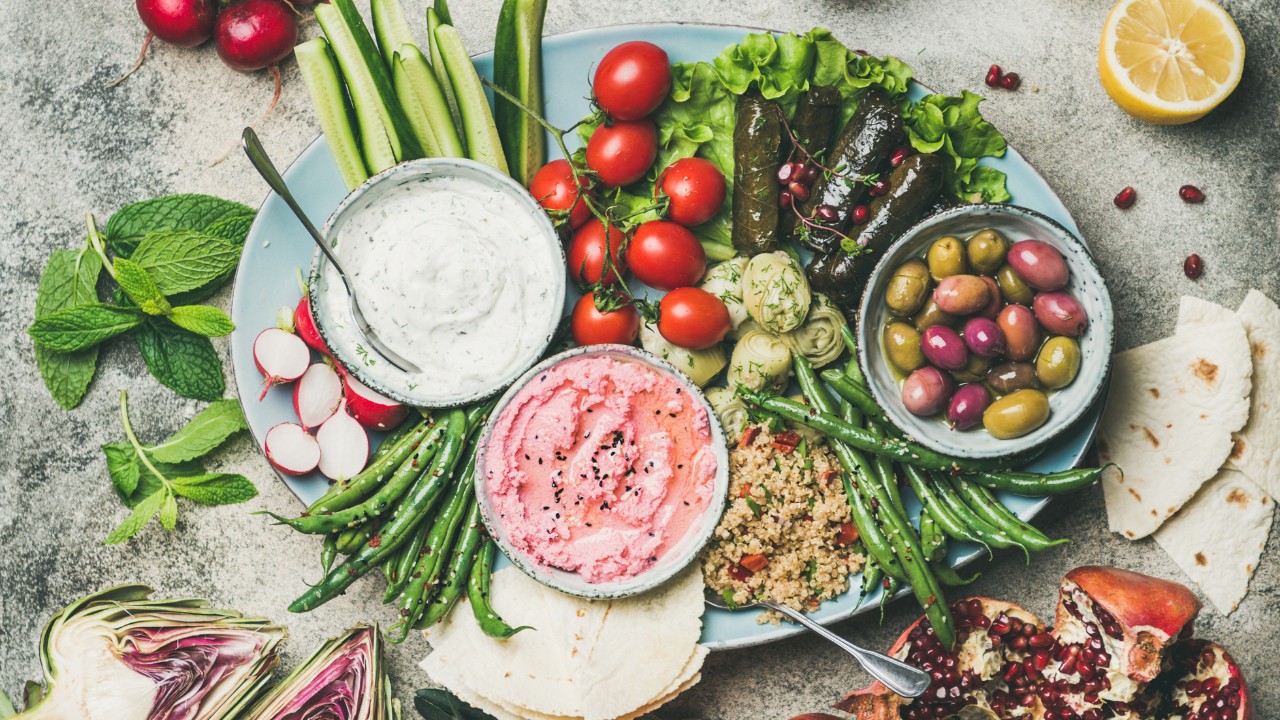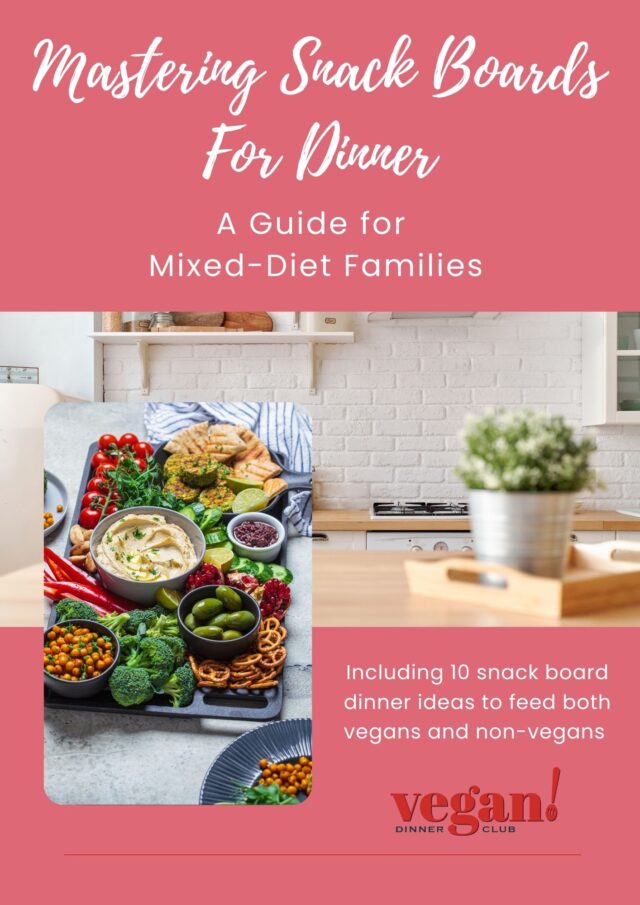Are you struggling to find dinner options that cater to everyone in your mixed-diet family? Whether you’re juggling plant-based, vegetarian, or omnivorous preferences, snack boards might just be your new best friend. These versatile and visually appealing spreads are perfect for satisfying a variety of tastes and dietary needs all on one beautiful platter. Not only are they easy to assemble, but they also encourage healthy eating and make dinner time a fun and interactive experience for the whole family. Snack boards are especially great for vegans in non-vegan families, providing a solution that allows everyone to enjoy the same meal without compromising on their dietary choices.
Table of Contents
What Are Snack Boards?
Snack boards, often known as charcuterie boards or grazing boards, are a collection of bite-sized snacks artfully arranged on a platter or board. Traditionally, they include an assortment of cheeses, meats, fruits, nuts, and other finger foods. However, the beauty of snack boards lies in their adaptability. They can be customized to fit any dietary preference or occasion, making them an ideal solution for families with diverse eating habits, especially those with both vegans and non-vegans.
Why You’ll Love Snack Boards
Unlike regular snack plates, snack boards are designed to be visually enticing and offer a balanced variety of flavors, textures, and nutrients. They can range from simple to elaborate, depending on the time you have and the ingredients you choose. By incorporating a mix of plant-based and traditional items, you can create a harmonious dining experience where everyone can find something they love.
Snack boards make it easy to accommodate different dietary needs without the stress of preparing multiple dishes. For instance, you can include a variety of vegan cheeses, dips, and plant-based proteins alongside traditional cheeses and meats. This way, everyone can enjoy the same meal, and vegans don’t feel like they have to eat separately from the rest of the family.
By creating a snack board, you’re not just offering food; you’re providing an experience. It’s an opportunity to bring the family together, encourage conversation, and enjoy the simple pleasure of sharing a delicious and thoughtfully arranged meal. Snack boards transform dinner from a routine task into an enjoyable, inclusive event that caters to all dietary preferences.
Components For Snack Boards
Creating a snack board that pleases everyone in your mixed-diet family involves selecting a variety of components that cater to different tastes and dietary preferences. Here are some essential components to include on your snack board:
1. Proteins
- Plant-Based Options: Offer a range of vegan proteins like marinated tofu, tempeh slices, chickpea salad, or falafel balls.
- Meat Options: Include cured meats like salami, prosciutto, and slices of roast chicken or turkey for the non-vegans in the family.
2. Cheeses
- Dairy-Free Cheeses: There are many delicious plant-based cheeses available now, including almond-based ricotta, cashew cheese, and vegan cheddar slices.
- Dairy Cheeses: Traditional cheese options like cheddar, brie, gouda, and mozzarella can be included for those who prefer dairy.
3. Fruits and Vegetables
- Fresh Fruits: Grapes, apple slices, berries, and dried fruits like apricots and figs add sweetness and a refreshing contrast to the other components.
- Fresh Vegetables: Include a variety of colorful veggies such as cherry tomatoes, cucumber slices, bell pepper strips, carrot sticks, and snap peas. They add crunch and vibrant color to the board.
4. Dips and Spreads
- Vegan Dips: Hummus, guacamole, baba ganoush, and dairy-free yogurt dips are great for adding flavor and variety.
- Traditional Dips: Include options like spinach and artichoke dip, ranch dressing, and cheese spreads for those who prefer them.
5. Crackers and Bread
- Gluten-Free and Vegan Crackers: Provide a selection of gluten-free and vegan crackers, rice cakes, and seed crackers to accommodate various dietary needs.
- Traditional Crackers and Bread: Include a variety of whole grain crackers, baguette slices, and breadsticks.
6. Nuts and Seeds
- Roasted Nuts: Almonds, cashews, walnuts, and pistachios add a crunchy texture and are great for snacking.
- Seeds: Pumpkin seeds, sunflower seeds, and chia seed-based snacks can be sprinkled around the board for extra nutrition.
7. Sweet Treats
- Vegan Sweets: Dark chocolate pieces, coconut macaroons, and energy balls made from dates and nuts are delicious vegan options.
- Traditional Sweets: Include milk chocolate, yogurt-covered pretzels, and small cookies for those who enjoy them.
By thoughtfully selecting and arranging these components, you can create a snack board that is not only visually appealing but also satisfying for every member of your family. The key is to ensure a balance of flavors, textures, and nutrients, making it a perfect meal for vegans, vegetarians, and omnivores alike.
Types of Snack Boards
Snack boards can be customized in endless ways to suit various occasions, dietary preferences, and taste profiles. Here are some popular types of snack boards that can cater to mixed-diet families, with a base of vegan options and adaptations for non-vegans:
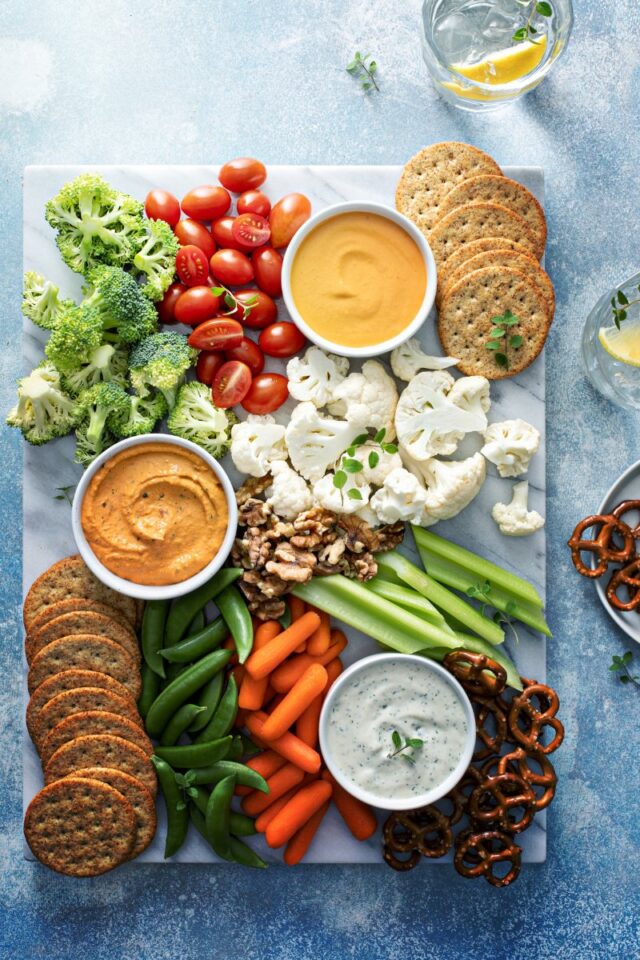
1. Classic Charcuterie Board
A traditional charcuterie board typically includes a selection of cured meats, cheeses, fruits, nuts, and crackers.
- Vegan Base: A selection of plant-based meats like vegan salami, smoked tofu, and a variety of vegan cheeses. Complement these with fruits, nuts, and crackers.
- Non-Vegan Adaptation: Add traditional cured meats such as salami, prosciutto, and slices of roast chicken or turkey. Include a few dairy cheeses like cheddar, brie, and gouda.
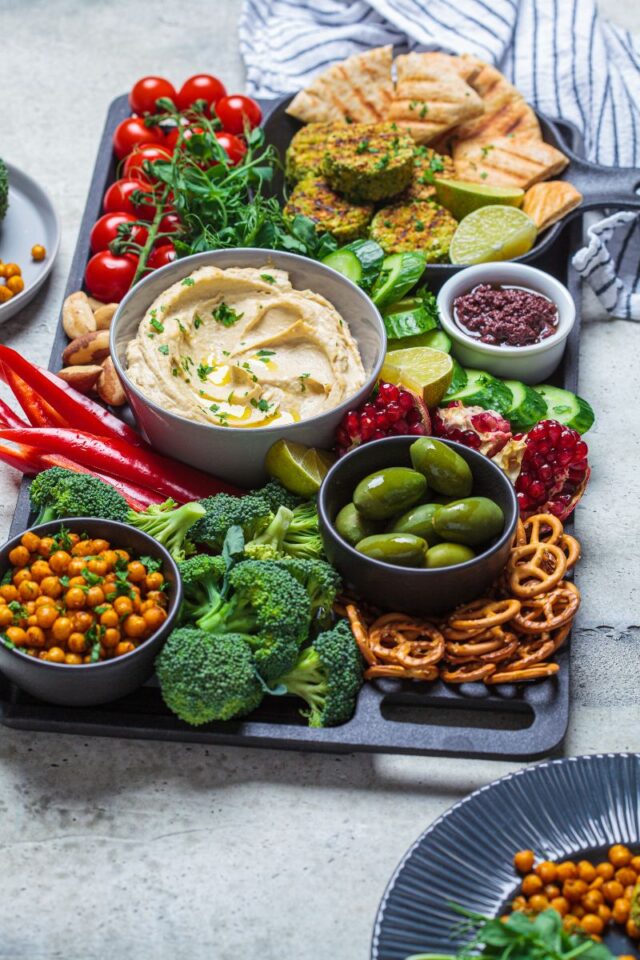
2. Mediterranean Mezze Board
This board is inspired by the flavors of the Mediterranean and usually features hummus, pita bread, olives, tabbouleh, and roasted vegetables.
- Vegan Base: Hummus, baba ganoush, pita bread, olives, tabbouleh, marinated tofu, and roasted vegetables.
- Non-Vegan Adaptation: Include traditional tzatziki, feta cheese, and grilled chicken skewers alongside the vegan options.
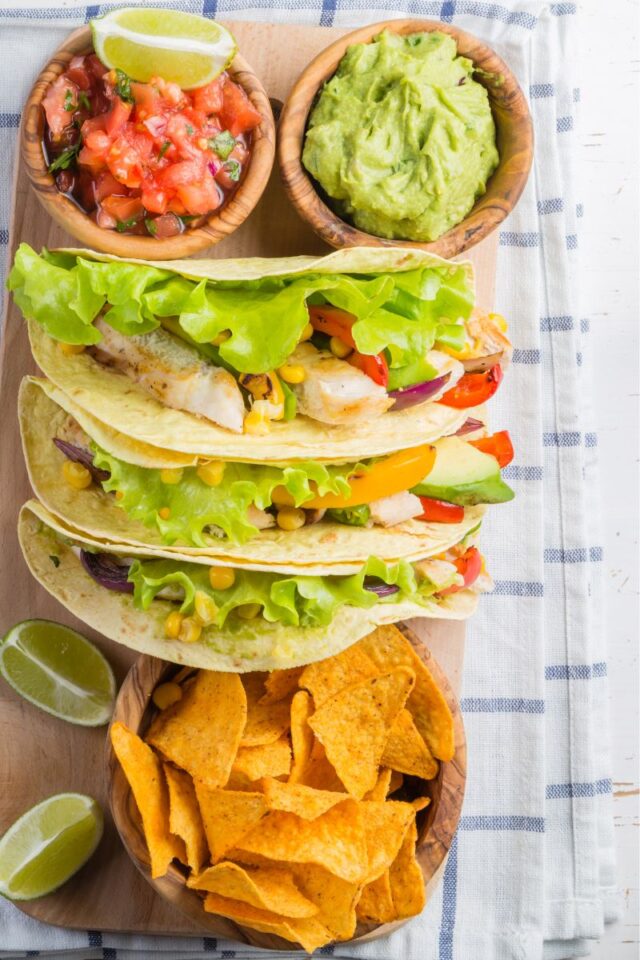
3. Tex-Mex Fiesta Board
A fun, flavorful board featuring taquitos or empanadas, chips, salsa, guacamole, cucumbers and jicama sticks with lime juice and chile lime salt, and pico de gallo.
- Vegan Base: Guacamole, salsa, tortilla chips, fresh veggies, and vegan queso.
- Non-Vegan Adaptation: Include traditional cheese, chicken fajita strips, and regular sour cream alongside the vegan options.
For more 7 more ideas for snack boards, get my free download here.
Additional Tips for Snack Boards
Planning and Preparation
Creating the perfect snack board for a mixed-diet family involves more than just picking the right components. Here are some additional tips to help you assemble a snack board that is not only delicious but also visually appealing and satisfying for everyone:
1. Balance Flavors and Textures
- Variety is Key: Ensure you have a mix of flavors (sweet, salty, savory) and textures (crunchy, creamy, chewy) to keep everyone’s taste buds excited.
- Contrast: Pair strong flavors with mild ones. For example, spicy marinated tofu can be balanced with cooling cucumber slices or a creamy dip.
2. Presentation Matters
- Visual Appeal: Arrange the components in a visually appealing way. Use a large wooden board or platter and group similar items together while spreading colors and textures evenly across the board.
- Garnishes: Fresh herbs like parsley, cilantro, or rosemary can add a pop of color and freshness to your board.
3. Portion Sizes
- Consider the Size: Make sure there’s enough for everyone to enjoy, but also be mindful of portion sizes to avoid waste. You can always refill the board as needed.
- Individual Portions: In addition to a large shared board, consider creating small, individual snack plates, especially for younger children who may prefer their own servings.
4. Dietary Labels
- Clear Identification: If your family or guests have specific dietary restrictions, consider labeling the vegan and non-vegan items clearly to avoid any confusion.
- Separate Sections: Arrange the board so that vegan and non-vegan items are grouped together in separate sections to prevent cross-contamination.
5. Incorporate Seasonal Produce
- Freshness: Use seasonal fruits and vegetables to ensure the freshest and most flavorful options.
- Sustainability: Seasonal produce is often more sustainable and can add a variety of colors and flavors to your board.
6. Make Ahead
- Preparation: Many components of a snack board can be prepared ahead of time. Cut fruits and vegetables, make dips, and even slice vegan meats and cheeses in advance to save time.
- Storage: Keep prepped items in airtight containers in the fridge and assemble the board just before serving to maintain freshness.
7. Interactive Elements
- DIY Sections: Include elements that allow family members to customize their own snacks. For example, provide a variety of crackers, dips, and toppings so everyone can create their perfect bite.
- Engagement: This not only makes the meal more interactive and fun but also ensures everyone gets exactly what they want.
8. Leftover Management
- Reuse: Plan to incorporate any leftover items into your meals for the next day. Leftover fruits can be added to breakfast smoothies, and veggies can go into salads or stir-fries.
- Storage: Store any leftovers properly to maintain freshness and avoid waste.
FAQs
How do I make sure my snack board has enough variety to please everyone in my family?
What are some easy vegan substitutions for traditional snack board items?
How can I prevent cross-contamination between vegan and non-vegan items?
What are some good protein options for a vegan snack board?
How far in advance can I prepare a snack board?
Can snack boards be used as a main meal or are they just for snacks?
How do I keep the snack board interesting and avoid repetition?
Are snack boards suitable for children?
Happy Snack Boarding!
Snack boards are a fantastic solution for mixed-diet families, offering a fun, flexible, and inclusive way to enjoy meals together. By starting with a vegan base and adding non-vegan options, you can create a diverse and satisfying spread that caters to everyone’s dietary preferences. The variety of flavors, textures, and components ensures that every meal is unique dinner experience.
With a little creativity and planning, snack boards can transform your dinner routine from a source of stress to a highlight of your day. They provide an opportunity to explore new foods, reduce food waste, and save time and money. Plus, they bring everyone together around the table, fostering connection and joy over shared meals. It’s one of my favorite dinner ideas during the summer months when the days are long and lazy and I don’t feel like cooking.
Whether you’re preparing a classic charcuterie board or a vibrant Mediterranean mezze board, the possibilities are endless. Use your imagination and family’s preferences to explore and have fun with this meal idea. Your family will love the variety and the opportunity to enjoy a meal that meets everyone’s needs. Happy snack boarding!
If you enjoyed these ideas for snack boards and want even more inspiration, be sure to download my free guide, packed with more fun and delicious dinners.
Other Resources You May Enjoy
- Sheet Pan Meals: The Dinner Solution for Mixed-Diet Families
- How to Create Joyful Meals with Versatile Food Bars
- The Ultimate Step-by-Step Guide To Thriving As A Vegan in a Non-Vegan Family
- Family-Friendly Meal Ideas For Mixed-Diet Families
- Theme Nights: Bringing Vegans and Non-Vegans Together At the Dinner Table

